Poplar Hospital
303-315 East India Dock Road, Poplar,
E14 0HP
Medical dates:
Medical character:
1855 - 1975
Trauma. Later, general
The Poplar Hospital for Accidents ("the Dockers'
Hospital") opened in 1855 with 20 beds in a former Customs House across
the road from the entrance gate to the East India Docks. It
treated male workers injured in the East and West India Docks (and
later Millwall Dock). The main initiative for its establishment
came from Samuel Gurney (1786-1856) and Money Wigram (1790-1873), a
Blackwall shipbuilder and shipowner. Gurney, a Quaker banker,
decided that a local hospital was necessary after a seriously injured
labourer died on the way to the London Hospital in Mile End - the
nearest hospital to the docks. Both Gurney and Wigram were
connected with the London
Hospital and they had suggested in 1854 that
the proposed hospital in Poplar should be attached to the London
Hospital, but this was not acceptable. The possibility of this
was mooted again in 1868, but again to no effect.
By 1870 activities in the docks had greatly declined, so there were
fewer casualties. The Hospital began to accept medical cases for
treatment. In 1874 an adjacent house was rented to use as accommodation
for the nursing staff.
An Out-Patients wing was added to the west of the Hospital building in 1880 at a cost of about £2,500. The 5-bay frontage on East India Dock Road was also extended westward by two bays. In 1886 the Hospital purchased the freehold of the site from the East and West India Dock Co. In 1890 two houses in East India Dock Road were bought.
In 1892 Queen Victoria became an annual subscriber and a life governor, thus increasing the level of funding.
In 1894 a 4-storey wing was completed on the east side of the Hospital building. It contained three floors of wards and had an Out-Patients Department in the basement. This expansion enabled women and children to be admitted for the first time. The old building was converted into staff accommodation and a conservatory was added over the porch. The improvements had cost about £22,300.
The Hospital was extended further in 1899, with an isolation block being built at the back of the site. A new wing was erected on the site of houses at Nos. 311-315 East India Dock Road, which had been purchased for £4,200. This new wing, built of brick and stone to the east of the 1894 wing, was five and a half storeys high, with a polygonal tower at its far end. The Hospital now provided general treatment facilities for the Poplar district.
In 1910 the Hospital began to undertake the dental care of schoolchildren, following an agreement with the LCC. In the same year some 345 workmen, injured during the building of the Thunderer, a Dreadnought-class battleship, at the Thames Iron Works, also received treatment.
During WW1 the Hospital was affiliated to the Fourth London General Hospital, and 24 of its beds were reserved for military casualties. The Hospital buildings suffered from Zeppelin raids, being badly damaged by bombs.
In 1917 it received casualties from the Silvertown explosion,
when 50 tons of TNT exploded at Brunner Mond's chemical works on
19th January. Sixty-nine people were killed and 450 injured.
The Hospital overflowed with the injured; 40 people were
admitted, of whom 7 died.
(Silvertown was named from SW Silver & Co, the rubber and telegraph
works, which covered 17 acres and employed 4000 people by 1923)
After the War further rebuilding took place and continued until
1929. The Hospital was extended at the rear to include Nos. 33-41
Athol Street. The 1881 west wing was demolished and rebuilt in
1922, and a children's ward, a Nurses' Home and a mortuary were added.
The total cost of the building work was about £80,000. A
new operating theatre was also installed in 1929.
In 1934 a larger Out-Patients Department was built, which extended northwards along Brunswick Road, at a cost of £22,159. An extra storey was added to the original 1894 east wing during 1936-37. In 1937 the Hospital dropped the words 'for Accidents' from its name on the basis that it had long been a general hospital.
During WW2 the original main building was destroyed by bombing in 1941. A number of people were killed and the Hospital was forced to close for a short time.
In 1948 the Hospital joined the NHS, under the control of the
Bow Group Hospital Management Committee (then under the Thames Group
Hospital Management Committee in 1963), part of the North East
Metropolitan Regional Hospital Board.
By 1950 the original Hospital had been mainly replaced by more functional buildings, but the decline of the inner London docks rendered it obsolete. It closed in 1975 and, despite protests from the local residents, who wanted to keep the buildings for community use, it was demolished in 1982.
|
Present status
(March 2008) |
|---|
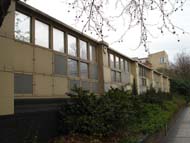
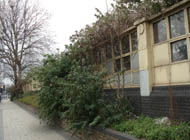
This old fencing may have been part of the Hospital boundary wall.
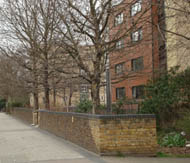

New housing and new road layouts (above
and below) have replaced the Hospital buildings.
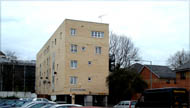

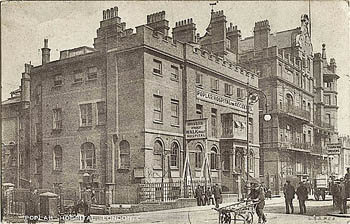
The Poplar Hospital for Accidents.
(Photograph reproduced by kind permission of
robmcrorie
- flickr)
References
(Author unstated) 1917 List of the various hospitals treating military cases in the United Kingdom. London, H.M.S.O.